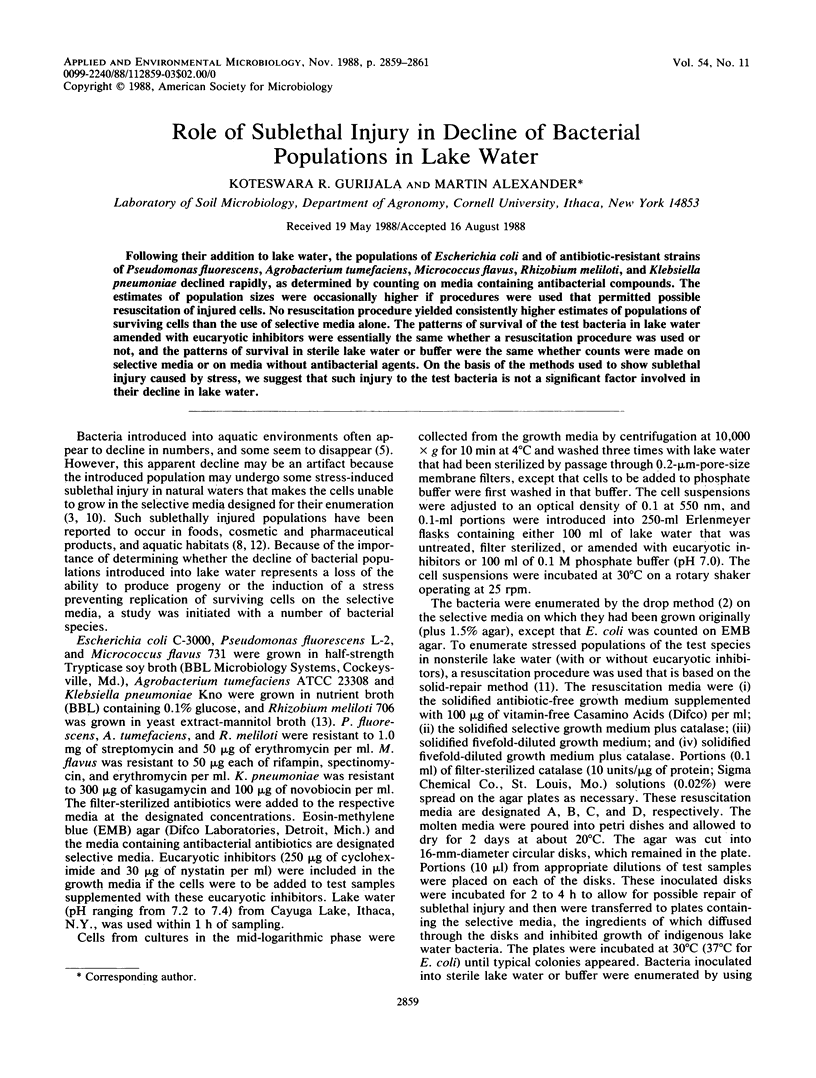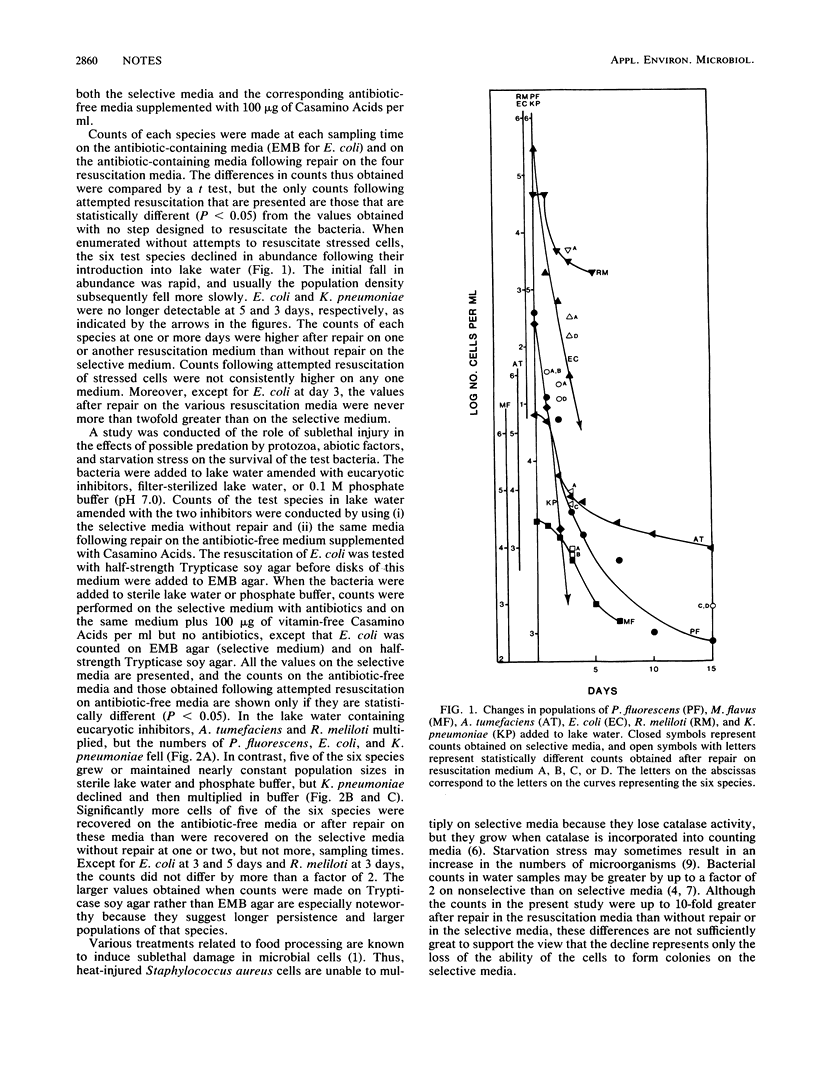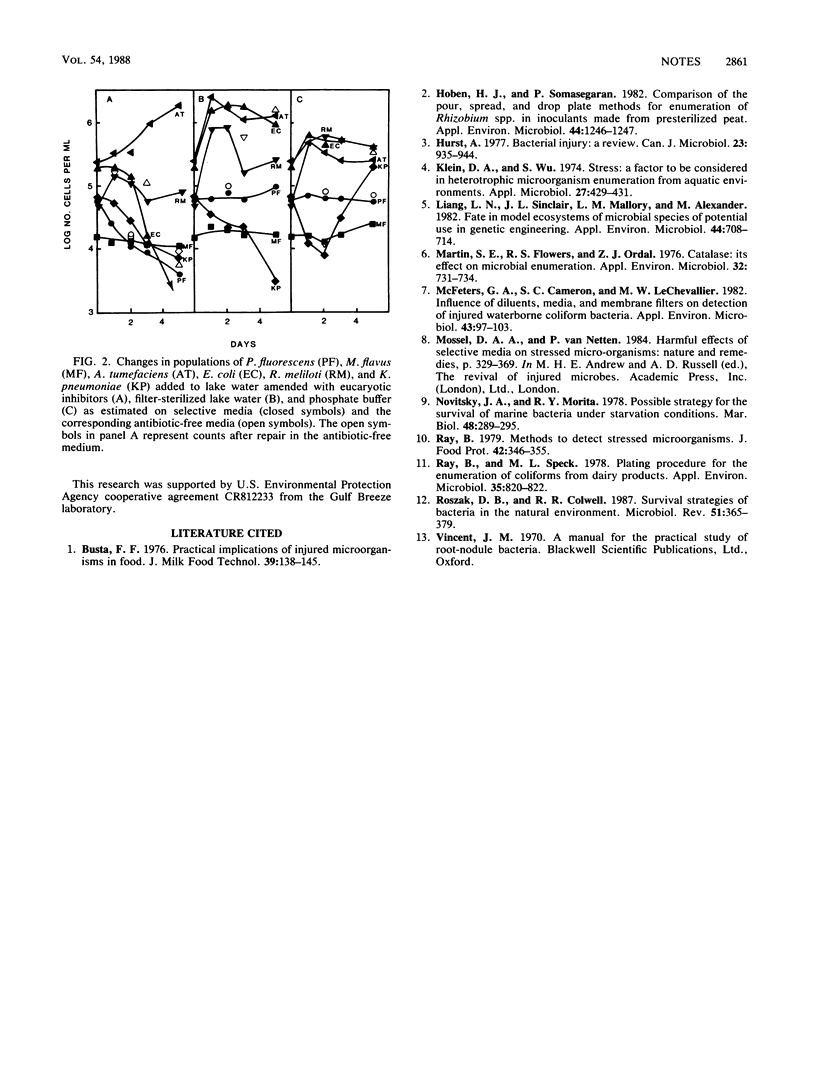Abstract
Following their addition to lake water, the populations of Escherichia coli and of antibiotic-resistant strains of Pseudomonas fluorescens, Agrobacterium tumefaciens, Micrococcus flavus, Rhizobium meliloti, and Klebsiella pneumoniae declined rapidly, as determined by counting on media containing antibacterial compounds. The estimates of population sizes were occasionally higher if procedures were used that permitted possible resuscitation of injured cells. No resuscitation procedure yielded consistently higher estimates of populations of surviving cells than the use of selective media alone. The patterns of survival of the test bacteria in lake water amended with eucaryotic inhibitors were essentially the same whether a resuscitation procedure was used or not, and the patterns of survival in sterile lake water or buffer were the same whether counts were made on selective media or on media without antibacterial agents. On the basis of the methods used to show sublethal injury caused by stress, we suggest that such injury to the test bacteria is not a significant factor involved in their decline in lake water.
Full text
PDF


Selected References
These references are in PubMed. This may not be the complete list of references from this article.
- Hoben H. J., Somasegaran P. Comparison of the Pour, Spread, and Drop Plate Methods for Enumeration of Rhizobium spp. in Inoculants Made from Presterilized Peat. Appl Environ Microbiol. 1982 Nov;44(5):1246–1247. doi: 10.1128/aem.44.5.1246-1247.1982. [DOI] [PMC free article] [PubMed] [Google Scholar]
- Hurst A. Bacterial injury: a review. Can J Microbiol. 1977 Aug;23(8):935–944. doi: 10.1139/m77-139. [DOI] [PubMed] [Google Scholar]
- Klein D. A., Wu S. Stress: a factor to be considered in heterotrophic microorganism enumeration from aquatic environments. Appl Microbiol. 1974 Feb;27(2):429–431. doi: 10.1128/am.27.2.429-431.1974. [DOI] [PMC free article] [PubMed] [Google Scholar]
- Liang L. N., Sinclair J. L., Mallory L. M., Alexander M. Fate in model ecosystems of microbial species of potential use in genetic engineering. Appl Environ Microbiol. 1982 Sep;44(3):708–714. doi: 10.1128/aem.44.3.708-714.1982. [DOI] [PMC free article] [PubMed] [Google Scholar]
- Martin S. E., Flowers R. S., Ordal Z. J. Catalase: its effect on microbial enumeration. Appl Environ Microbiol. 1976 Nov;32(5):731–734. doi: 10.1128/aem.32.5.731-734.1976. [DOI] [PMC free article] [PubMed] [Google Scholar]
- McFeters G. A., Cameron S. C., LeChevallier M. W. Influence of diluents, media, and membrane filters on detection fo injured waterborne coliform bacteria. Appl Environ Microbiol. 1982 Jan;43(1):97–103. doi: 10.1128/aem.43.1.97-103.1982. [DOI] [PMC free article] [PubMed] [Google Scholar]
- Mossel D. A., Van Netten P. Harmful effects of selective media on stressed micro-organisms: nature and remedies. Soc Appl Bacteriol Symp Ser. 1984;(12):329–369. [PubMed] [Google Scholar]
- Ray B., Speck M. L. Plating procedure for the enumeration of coliforms from dairy products. Appl Environ Microbiol. 1978 Apr;35(4):820–822. doi: 10.1128/aem.35.4.820-822.1978. [DOI] [PMC free article] [PubMed] [Google Scholar]
- Roszak D. B., Colwell R. R. Survival strategies of bacteria in the natural environment. Microbiol Rev. 1987 Sep;51(3):365–379. doi: 10.1128/mr.51.3.365-379.1987. [DOI] [PMC free article] [PubMed] [Google Scholar]


